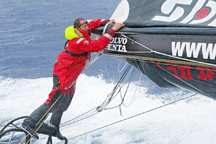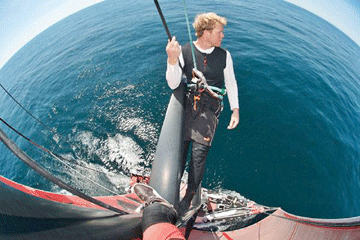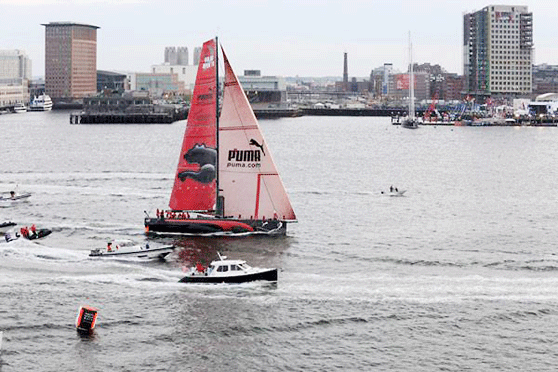
Volume XVII, Issue 18 # April 30 - May 6, 2009 |
 |
The Volvo Ocean Race, Leg 6
Steaming nearly 5,000 miles from Rio de Janeiro to Boston

by Steve Carr
We last saw the reduced Volvo fleet of five boats sailing into Brazil’s Guanabara Bay after the Ocean Race’s most arduous leg: 12,300 miles achieved by the winner, Telefonica Blue, in 41 days.
The start of Leg Six to Boston was sunny and warm as the Spanish boat Telefonica Black blasted out of Guanabara Bay into the Atlantic ahead of the reconstituted pack of seven. Skipper Fernando Echavarri was back at the helm after the black boat withdrew from Leg Five with severe hull damage and was shipped to Rio.
The next few days were a cat-and-mouse game as the boats reached up the coast of Brazil on the wings of a tricky southeast trade wind, some hugging the shore and others farther out to sea. Second-place Telefonica Blue seemed to be on a roll after gaining points in in-port racing, quickly moving to the front, dodging dead-air squalls and clouds.
Then the race became the sailing equivalent of Ground Hog Day, with the shore breeze (left) dominating each morning and lifting the inshore boats up the leader board. Then the sea breeze (right) filled in each afternoon, blessing the boats farther out to sea.

 After seven days of nerve-racking sailing, with the boats often within sight of one another, the scoring gate at Fernando de Noronha — a volcanic island of black basalt, located about 60 miles off the coast of Brazil — loomed on the horizon. The trick was to get there first and to line your boat up for the next phase of the race, the Doldrums along the equator. This too was sort of like old home week because the Volvos had used this rocky island as a scoring gate on their way south from Spain to Capetown during Leg One. Then they had a devil of a time trying to find the shortest track through the light-air Doldrums.
After seven days of nerve-racking sailing, with the boats often within sight of one another, the scoring gate at Fernando de Noronha — a volcanic island of black basalt, located about 60 miles off the coast of Brazil — loomed on the horizon. The trick was to get there first and to line your boat up for the next phase of the race, the Doldrums along the equator. This too was sort of like old home week because the Volvos had used this rocky island as a scoring gate on their way south from Spain to Capetown during Leg One. Then they had a devil of a time trying to find the shortest track through the light-air Doldrums.
Telefonica Blue continued its hard-charging comeback by blasting through the scoring gate and picking up four more points, followed closely by Ericsson 4. Delta Lloyd grabbed third with Puma only one minute behind after rolling Telefonica Black a few minutes before the gate.
An Amazing Race
This was turning into an amazing race, as only 14 miles separated second from sixth place.
With 3,500 miles to go, the northeasterly trade winds were kicking in at nearly 20 knots, allowing Telefonica Blue to extend her lead day by day. She was getting the fresh wind ahead of the trailing boats, which had formed two trailing flanks from west to east.
The sailing was power reaching, with fire-hose waves coming over the deck. And if you snooze, you lose. Onboard Ericsson 3, the winner of Leg Five, veteran skipper Magnus Olsson was helping to change sails when a rogue wave knocked him back into the steering wheel. He was out cold with a broken rib.
As often happens in long-distance sailing, the boat at the front eventually hits a wall. Telefonica Blue hit a big high pressure system of light winds drifting west from the Azores. The boats at the back ride more wind and catch up.
As the fleet compressed, Telefonica Black ran into all sorts of trouble.
“This was not what you call a normal night,” bemoaned skipper Fernando Echavarri. “Too many incidents in a few hours. Just after midnight, we had just changed to the A5, when we hit a squall [and] broke the gennaker sheet. Two hours later we were sailing in a dark night at 22 to 24 knots and suddenly we hit a [whale] … A few hours later the jib halyard bullet broke.”

Decision Time
Meanwhile, Telefonica Blue tacked crazily to find steadier winds before the fleet could catch up. The rains that had hit Annapolis and the East Coast were now barreling toward the fleet. It was decision time. Blue could keep heading north and probably get caught — or tack away to the west and try and ride the storm. To complicate the approach to the finish, the Volvos also had to avoid the 240 square mile Stellwagen Bank National Marine Whale Sanctuary just east of Boston.
When Blue’s lead on Ericsson 4 had dropped from 108 miles to only six, the boat went into Stealth Mode. In this new feature of the Volvo Ocean Race, a boat can become invisible for 12 hours. As soon as Blue dropped off the magical game board, the boat gybed onto port tack and popped the spinnaker, heading almost directly toward Boston.
Three hours later, Ericsson 4 gybed and went into Stealth so that no one knew its whereabouts, either.
The next day, again visible Ericsson 4 was 500 miles from home and leading the pack for the first time in Leg Six — but with a broken watermaker. But only 70 miles separated first and last, with tricky weather and the Gulf Stream to deal with. It was anyone’s race to win or lose.
I nto Boston
nto Boston
The ending was a tense battle of wills as the wind petered out and the boats drifted tired and sore into Boston. Overall leader Ericsson 4 capped off an epic performance by winning Leg Six, followed 13 minutes later by the Volvo rookies on Ericsson 3, who continue to turn heads in the sailing world with yet another rock-solid performance. Telefonica Blue held off hometown favorite Puma to take third.
Ericsson 4 now leads with 771⁄2 points, followed by Telefonica Blue with 641⁄2. Puma is in close third with 64.